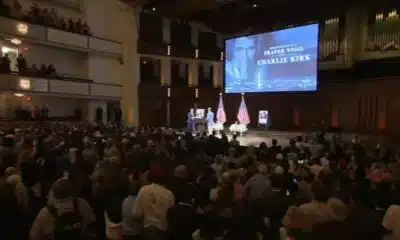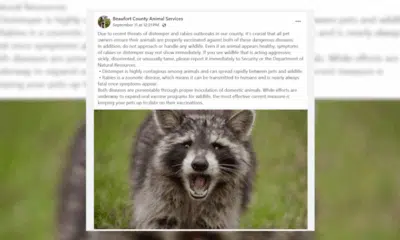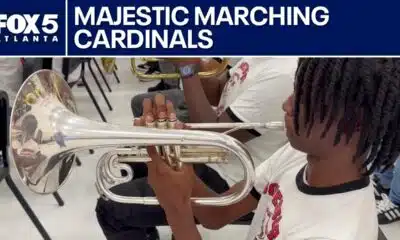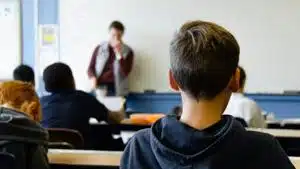News from the South - Alabama News Feed
Guns kill more US children than other causes, but state policies can help, study finds
by Nada Hassanein, Alabama Reflector
June 17, 2025
This story originally appeared on Stateline.
More American children and teens die from firearms than any other cause, but there are more deaths — and wider racial disparities — in states with more permissive gun policies, according to a new study.
The study, published in the medical journal JAMA Pediatrics last week, analyzes trends in state firearm policies and kids’ deaths since 2010, after the landmark U.S. Supreme Court decision in McDonald v. City of Chicago. The ruling struck down the city’s handgun ban, clearing the way for many states to make it easier for people to buy and carry guns.
The study authors split states into three groups: “most permissive,” “permissive” and “strict,” based on the stringency of their firearm policies. Those policies include safe storage laws, background checks and so-called Stand Your Ground laws. The researchers analyzed homicide and suicide rates and the children’s race.
GET THE MORNING HEADLINES.
Using statistical methods, the researchers calculated 6,029 excess deaths in the most permissive states between 2011 and 2023, compared with the number of deaths that would have been expected under the states’ pre-McDonald rules. There were 1,424 excess deaths in the states in the middle category.
In total, about 17,000 deaths were expected in the post-decision period, but 23,000 occurred, said lead author Dr. Jeremy Faust, an emergency physician at Brigham and Women’s Hospital in Boston, in an interview.
Among the eight states with the strictest laws, four — California, Maryland, New York and Rhode Island — saw statistically significant decreases in their pediatric firearm death rates. Illinois, which was directly affected by the court’s decision in the McDonald case, and Connecticut saw increases in their rates. In Massachusetts and New Jersey, the changes were not statistically significant.
The rate increased in all but four (Alaska, Arizona, Nebraska and South Dakota) of the 41 states in the two permissive categories. (Hawaii was not included in the study due its low rates of firearm deaths.)
Non-Hispanic Black children and teens saw the largest increase in firearm deaths in the 41 states with looser gun laws. Those youths’ mortality rates increased, but by a much smaller amount, in the states with strict laws.
Experts say the study underscores the power of policy to help prevent firearm deaths among children and teens. The analysis comes less than a month after the release of a federal report on children’s health that purported to highlight the drivers of poor health in America’s children but failed to include anything on firearm injuries — the leading cause of death for children and teens in 2020 and 2021, according to the federal Centers for Disease Control and Prevention.
Trauma surgeon Dr. Marie Crandall, chair of surgery at MetroHealth medical center and a professor at Case Western Reserve University School of Medicine in Cleveland, researches gun violence. She previously practiced at a Jacksonville, Florida, urban trauma unit, where she frequently saw children and teens caught in gun violence.
“When I see children come in with 10 holes in them that I can’t save — that is a loss. That is a completely preventable death, and it is deeply emotionally scarring to have to have those conversations with families when we know, as a society, there are things we could do to de-escalate,” said Crandall, who wasn’t involved in the new study.
When I see children come in with 10 holes in them that I can’t save — that is a loss. That is a completely preventable death.
– Dr. Marie Crandall, chair of surgery, MetroHealth medical center, Cleveland
In her state of Ohio, firearm death rates among children and teens increased from 1.6 per 100,000 kids in the decade before the McDonald decision to 2.8 after it, according to the study. Ohio was categorized in the group with the most permissive laws.
The study adds to previous research that shows state laws around child access to firearms, such as safe storage and background checks, tend to be associated with fewer child firearm deaths.
“We know that child access prevention decreases unintentional injuries and suicides of children. So having your firearms locked, unloaded, stored separately from ammunition, decreases the likelihood of childhood injuries,” Crandall said. “More stringent regulation of those things also decreases childhood injuries.”
But she said it’s hard to be optimistic about more stringent regulation when the current administration dismisses gun violence as a public health emergency. The Trump administration earlier this year took down an advisory from the former U.S. surgeon general, issued last year, that emphasized gun violence as a public health crisis.
Faust, the lead author of the new study, stressed that firearm injuries and deaths were notably missing from the Make America Healthy Again Commission report on children’s health. He said the failure to include them illustrates the politicization of a major public health emergency for America’s kids.
“It’s hard to take them seriously if they’re omitting the leading cause of death,” Faust said. “They’re whiffing, they’re shanking. They’re deciding on a political basis not to do it. I would say by omitting it, they’re politicizing it.”
Faust and pediatric trauma surgeon Dr. Chethan Sathya, who directs the Center for Gun Violence Prevention at the Northwell Health system in New York, each pointed to the development of car seat laws and public health education, as examples of preventive strategies that helped reduce childhood fatalities. They support a similar approach to curbing youth gun deaths.
“We really have to apply a public health framework to this issue, not a political one, and we’ve done that with other issues in the past,” said Sathya, who wasn’t involved in the study and oversees his hospital’s firearm injury prevention programs. “There’s no question that this is a public health issue.”
In Louisiana, which the study categorized as one of the 30 most permissive states, the child firearm mortality rate increased from 4.1 per 100,000 kids in the pre-McDonald period to 5.7 after it — the nation’s highest rate. The study period only goes to 2023, but the state last year enacted a permitless carry law, allowing people to carry guns in public without undergoing background checks. And just last month, Louisiana legislators defeated a bill that would have created the crime of improper firearm storage.
Louisiana Democratic state Rep. Matthew Willard, who sponsored the safe storage legislation, said during the floor debate that its purpose was to protect children. Louisiana had the highest rate of unintentional shootings by children between 2015 to 2022, according to the research arm of Everytown for Gun Safety, which advocates for stricter gun access. Willard cited that statistic on the floor.
But Republican opponents said Willard’s proposal would infringe on residents’ gun rights and make it more difficult for them to use guns in self-defense.
“Nobody needs to come in our houses and tell us what to do with our guns. I think this is ridiculous,” Republican Rep. R. Dewith Carrier said during the debate.
Another Republican opponent, state Rep. Troy Romero, said he was concerned that having a firearm locked away would make it harder for an adult to quickly access it.
“If it’s behind a locked drawer, how in the world are you going, at 2 or 3 in the morning, going to be able to protect your family if somebody intrudes or comes into your home?” Romero said.
Gun violence researcher Julia Fleckman, an assistant professor, and her team at Tulane University in New Orleans have started to collect data on the impact of the state’s permitless carry law.
“It places a disproportionate impact on really vulnerable people, really, our most vulnerable people,” Fleckman said, noting kids bear the brunt of legislators’ decisions. “They don’t have a lot of control over this or the decisions we’re making.”
In South Carolina, another one of the most permissive states, the mortality rate increased from 2.3 to 3.9 per 100,000 kids in the time before and after the McDonald decision. South Carolina Democratic state Rep. JA Moore, who lost his adult sister in the 2015 racist shooting that killed nine at a Charleston church, said state policy alone isn’t enough. He implored his colleagues to also examine their perception of guns.
“We have a culture here in South Carolina that doesn’t lend itself to a more safe South Carolina,” said Moore, who added he’s been advocating for background checks and stricter carry laws. “There is a need for a culture change in our state, in our country, when it comes to guns and our relationships with guns as Americans, realizing that these are deadly weapons.”
‘Problematic’ MAHA report minimizes success of lifesaving asthma medicines, doctors say
And investing in safer neighborhoods is crucial, he said.
“People are hurt by guns in places that they’re more comfortable, like their homes in their own neighborhoods,” he said.
Community-based interventions are important to stemming violence, experts said. Crandall, the Cleveland surgeon, said there’s emerging evidence that hospital-based and community-based violence prevention programs decrease the likelihood of violent and firearm-related injury.
Such programs aim to break cycles of violence by connecting injured patients with community engagement services. After New York City implemented its hospital-based violence interruption program, two-thirds of 3,500 violent trauma patients treated at five hospitals received community prevention services.
After her 33-year-old son was killed in her neighborhood in 2019, Michelle Bell started M-PAC Cleveland — “More Prayer, Activity & Conversation” — a nonprofit collaborative of people who’ve lost loved ones to violent crime. She’s encountered many grieving parents who lost their children to gunfire. The group advocates and educates for safe storage laws and holds peer grief support groups.
She also partners with the school district in a program that shares stories of gun violence’s long-lasting impact on surviving children, families and communities and non-violent interpersonal conflict resolution.
“Oftentimes, the family that has lost the child, the child’s life has been taken by gun violence, there are other children in the home,” she said.
“It’s so devastating. It’s just so tragic that the No. 1 cause of death for children 18 and under is gun violence,” Bell continued.
The decision to “pull a trigger,” she said, changes a “lifetime of not only yours, but so many other people.”
Stateline reporter Nada Hassanein can be reached at nhassanein@stateline.org.
Stateline is part of States Newsroom, a nonprofit news network supported by grants and a coalition of donors as a 501c(3) public charity. Stateline maintains editorial independence. Contact Editor Scott S. Greenberger for questions: info@stateline.org.
Independent Journalism for All
As a nonprofit newsroom, our articles are free for everyone to access. Readers like you make that possible. Can you help sustain our watchdog reporting today?
Alabama Reflector is part of States Newsroom, a nonprofit news network supported by grants and a coalition of donors as a 501c(3) public charity. Alabama Reflector maintains editorial independence. Contact Editor Brian Lyman for questions: info@alabamareflector.com.
The post Guns kill more US children than other causes, but state policies can help, study finds appeared first on alabamareflector.com
Note: The following A.I. based commentary is not part of the original article, reproduced above, but is offered in the hopes that it will promote greater media literacy and critical thinking, by making any potential bias more visible to the reader –Staff Editor.
Political Bias Rating: Center-Left
The content presents a data-driven critique of permissive gun laws, linking them to increased pediatric firearm deaths and racial disparities. It highlights support for stricter gun control measures such as safe storage laws and background checks, as well as public health and community-based approaches to reducing gun violence. While it includes perspectives from both sides of legislative debates, it emphasizes the public health risks of lax gun regulations and critiques administration actions that minimize gun violence as a health crisis. This focus aligns with center-left viewpoints advocating for more gun control and government intervention to enhance safety, while still incorporating some balance through quotes from opponents of stricter laws.
News from the South - Alabama News Feed
A very dry September forecast with hot afternoons ahead for Alabama.
SUMMARY: Alabama faces a very dry September with hot afternoons continuing through the last week of summer before the autumnal equinox. Sunday begins comfortably cool in the 60s, warming to low 90s by mid-afternoon under mostly sunny skies. A weak wave may bring a few showers tonight, mainly to northwest Alabama, but widespread rain is unlikely. Temperatures will remain above average, hitting mid-90s Tuesday and Wednesday. By next weekend, a trough and front may increase cloud cover and rain chances slightly, potentially lowering temperatures closer to average. Overall, the forecast calls for persistent dry and warm conditions into next week.
A very dry September forecast with hot afternoons ahead for Alabama.
WVTM13 is your home for Alabama breaking news and weather. For your latest Alabama news and weather visit: https://www.wvtm13.com/
For licensing inquiries: https://www.wvtm13.com/licensing
News from the South - Alabama News Feed
Huntsville Fire & Rescue Holds 9/11 Memorial Service | Sept. 11, 2025 | News 19 at 5 p.m.
SUMMARY: On September 11, 2025, Huntsville Fire & Rescue held a memorial service to honor the nearly 3,000 lives lost in the 9/11 terrorist attacks. Military members and first responders gathered at Huntsville Fire Station One, where at 7:46 a.m., lights, sirens, and air horns sounded to replicate the sounds heard during the attacks. Fire Chief Howard McFarland emphasized the importance of remembering the tragedy to educate younger generations and prevent history from repeating. Former Captain Lynn recalled the shock of witnessing the attacks and noted how 9/11 reshaped emergency preparedness. This annual event is held across all 20 Huntsville fire stations.
The Huntsville Fire & Rescue held a 9/11 memorial service.
News 19 is North Alabama’s News Leader! We are the CBS affiliate in North Alabama and the Tennessee Valley since November 28, 1963.
https://whnt.com/
https://www.facebook.com/whntnews19
https://www.instagram.com/whntnews19/
https://twitter.com/whnt
News from the South - Alabama News Feed
News 5 NOW at 8:00am | September 11, 2025
SUMMARY: On September 11, 2025, News 5 NOW covered 9/11 commemorations, including first responders climbing 2,000 steps at Hancock Whitney Stadium to honor the World Trade Center’s 110 stories. The Original Oyster House offered free meals to first responders in Mobile and Baldwin counties. The program also reported a new Vibrio bacterial infection case in Escambia County, highlighting health warnings for beachgoers. Additionally, they discussed a study linking chronic insomnia to increased dementia risk, election recounts in Gulf Shores, and a recent political shooting in Utah, sparking debate over harsher punishments for political violence. Viewer opinions on extraterrestrials and political violence were shared in an interactive social media segment.
First Responders in Mobile honored the heroes of September 11th, a Pensacola woman is in the hospital after being infected with the flesh eating bacteria vibrio vulnificus, and a vote re-count wrapped up in Gulf Shores…
-
News from the South - Arkansas News Feed7 days ago
Group in lawsuit say Franklin county prison land was bought before it was inspected
-
News from the South - Kentucky News Feed6 days ago
Lexington man accused of carjacking, firing gun during police chase faces federal firearm charge
-
The Center Square6 days ago
California mother says daughter killed herself after being transitioned by school | California
-
News from the South - Arkansas News Feed6 days ago
Arkansas medical marijuana sales on pace for record year
-
Local News6 days ago
US stocks inch to more records as inflation slows and Oracle soars
-
Local News Video6 days ago
William Carey University holds 'tailgates and tourniquets' blood drive
-
News from the South - Alabama News Feed6 days ago
Zaxby's Player of the Week: Dylan Jackson, Vigor WR
-
News from the South - North Carolina News Feed4 days ago
What we know about Charlie Kirk shooting suspect, how he was caught














































